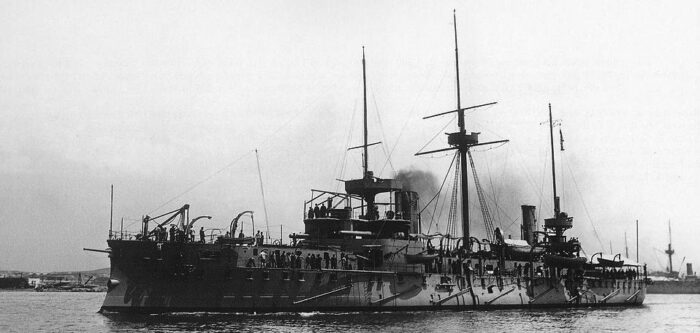
Hydra, Spetsai and Psara were ordered as coast defence ironclads in 1885 under the cabinet of Charilaos Trikoupis in order to modernize an ageing navy which earlier armoured ships went back to the 1860s. The three vessels were built in France, and were quite peculiar, with three main guns in a triangle pattern, a two-storey battery, three masts and two funnels, forecastle and lower deck, as well as a low freeboard and limited draught.
Ready in 1892, they frequently served together throughout their careers, taking part in Greco–Turkish War in 1897. They did well, establishing dominance in the Aegean Sea but could not prevent a defeat on land and national humiliation. They were modernized in the 1890s and 1900s. When the First Balkan War started they proved however too slow to keep up the new flagship, Italian-built armored cruiser Georgios Averof, altough taking part in the Battle of Elli and Battle of Lemnos. They were reduced to secondary duties and were bot strickly “in active duty” during World War I, and retained postwar until… 1929.
Development
Context
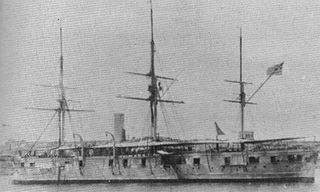 The Greek Navy before 1880 was composed of ageing armoured corvettes, 1700t British built Vasilefs Giorgios (1867) and Italian-built 2000t Vasilissa Olga (1869) as well as the Sloop Hellas (1861). There were also six 1856-58 300t iron screw gunboats and two sailing ships of 22 and 26 guns. It was clear at that point that the Navy needed a modernization, until then postponed due to a complicated political domestic situation. The country also lacked resources and was regarded as poor, this state of affair persisted until 1905. However already in the early 1880s there was some political will to change the situation, especially to deter a still all-powerful Ottoman Navy, which completely dwarved Hellenic forces.
The Greek Navy before 1880 was composed of ageing armoured corvettes, 1700t British built Vasilefs Giorgios (1867) and Italian-built 2000t Vasilissa Olga (1869) as well as the Sloop Hellas (1861). There were also six 1856-58 300t iron screw gunboats and two sailing ships of 22 and 26 guns. It was clear at that point that the Navy needed a modernization, until then postponed due to a complicated political domestic situation. The country also lacked resources and was regarded as poor, this state of affair persisted until 1905. However already in the early 1880s there was some political will to change the situation, especially to deter a still all-powerful Ottoman Navy, which completely dwarved Hellenic forces.
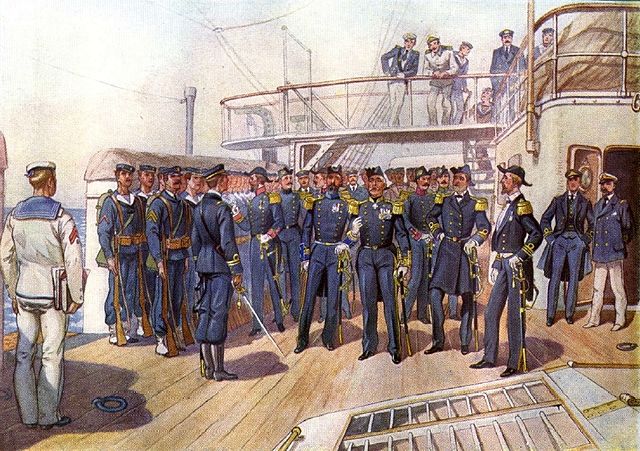
The Balkan crisis and Serbo-Bulgarian War plus the Ottoman naval expansion of the 1860s and 1870s (with a dozen of modern, large ironclads) prompted the Greek Navy to look at a rearmament program already in 1875, but ths situation was still not favourable. The souvenir of the 1866 Cretan Revolt, where teh greek Navy was too too weak to challenge Ottoman naval power was still a scar in collective memory.
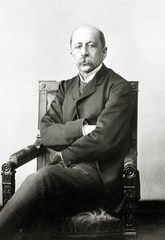 And thus the impetus came even prior 1880, in fact after 1878 Russo-Turkish War which urged the need to expand the Greek navy and create a new and larger naval base was at Faneromeni of Salamis. Later that base was transferred to Arapis, the Naval Academy was founded, Ilias Kanellopoulos being its first Director. A French naval mission headed by Admiral Laurent Joseph Lejeune arrived to install a new naval organization and methodological training of personnel via a new training school located at the naval base in Poros. Legendary PM Charilaos Trikoupis during his mandate from 3 March 1882 to 19 April 1885, under French advices pressed for the acquisition of new, modern battleships. This was to be the Hydra (or Spetsai class), from France.
And thus the impetus came even prior 1880, in fact after 1878 Russo-Turkish War which urged the need to expand the Greek navy and create a new and larger naval base was at Faneromeni of Salamis. Later that base was transferred to Arapis, the Naval Academy was founded, Ilias Kanellopoulos being its first Director. A French naval mission headed by Admiral Laurent Joseph Lejeune arrived to install a new naval organization and methodological training of personnel via a new training school located at the naval base in Poros. Legendary PM Charilaos Trikoupis during his mandate from 3 March 1882 to 19 April 1885, under French advices pressed for the acquisition of new, modern battleships. This was to be the Hydra (or Spetsai class), from France.
Design Influences
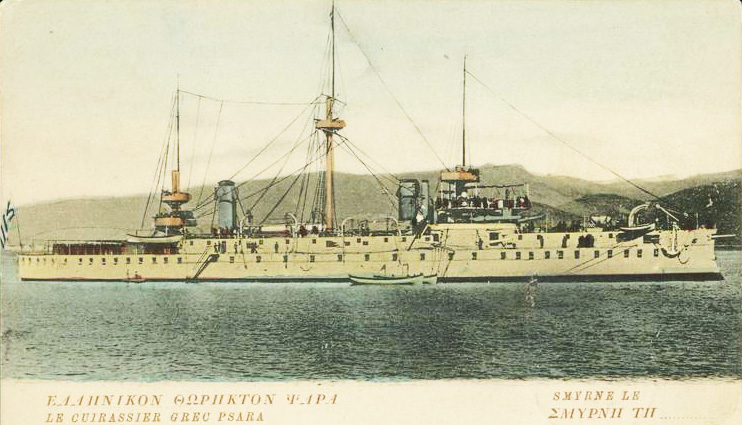
The Hydra class were not a 100% French design, the Greek delegation sent in France came up with many specifications coming from various influences, and they ended as very peculiar, unusual ships for the standard for the day, even French standards under the “Young School”. They were the boldest naval side upgrade amidst a wider reorganization and modernization of Greek armed forces ingeneral after their poor performances both in 1878 and in the Cretan uprising of 1866. The young school influence was clear in that they were given hefty guns, three 10.8-inch (274 mm) Canet models, and five 5.9-inch (150 mm) also Canet guns, for a top speed of 17 knots (31 km/h; 20 mph). They featured many classic underwater protection features of the day, notably heavy compartimentation and Creusot plus Compound armour. They had three masts and a schooner rigging planned. So these new ironclads were ordered from the Graville and St. Nazaire shipyards in France in 1885 and generally regarded as “deterrence ships” with a low freeboard, limited range but acceptable speed and agility, stable enough for their large guns and take advantage of the Aegean sea and Greek shores.
Design of the class
Hull and general design
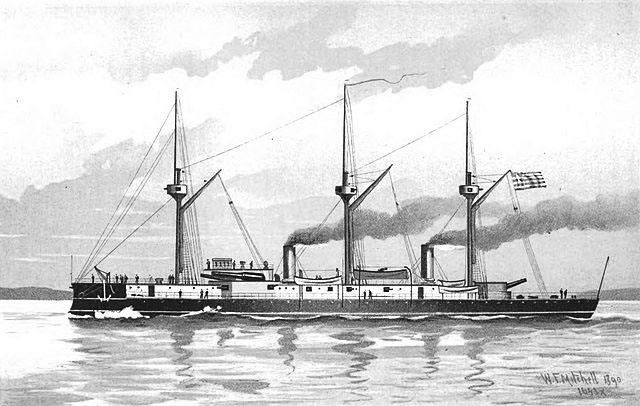
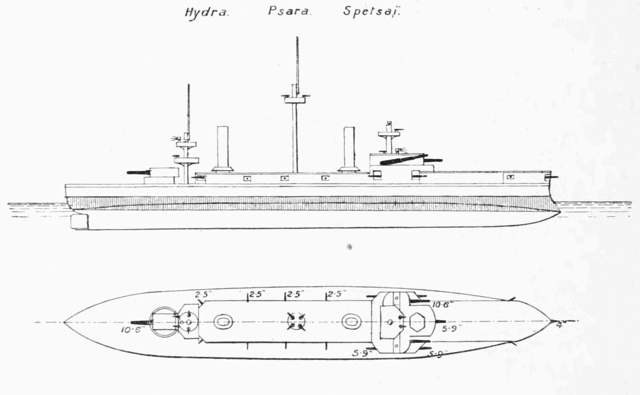
Brassey 1902 depictions
The ships were preculiar, relatively broad for a limited draft and to compensate, an equally low freeboard, with a forecastle and lower aft deck. They measured 334 feet 8 inches (102.01 m) long between perpendiculars (full lenght probably 104 m) with a beam of 51 ft 10 in (15.80 m) for a ration of . Mean draft was 18 ft (5.5 m). Displacement, 4,808 long tons (4,885 t) as built, probably around 5100-5200 tonnes fully loaded was already in-between coastal defence shiops and fully grown sea going ironclads. In 1910 modifications and addition had them rated for 4,885 long tons (4,963 t) standard.
They had so a forecastle continued by a long battery deck, bulwarked, and ended with the aft deck and single axial protected casemate which almost looked like a turret. The hull was peculiar, with the guns relatively close to the bow and stern, and an elliptical profile was was broad forward and aft and had an almost constant beam amidship. There was a ram bow of moderate slope and almost no tumblehome. Typically of French fashion they had squared portholes. The crew was composed of 400 officers and men.
Protection
The ships were armored with a mix of Creusot and compound steel. Displacement calculation proved wrong and their belt armour suffered from a full load, as it ended below water, making it ineffective.
Main belt 12 inches (305 mm) thick amidships tapared down to 4 inches (102 mm) forward and aft.
Normal displacement: 3 in (76 mm) above waterline, full load: completely submerged below the waterline.
Upper belt 3 inches (76 mm) armor strake.
Main battery casemate: 12-14 in (350mm sides and 300mm roof)
Main barbettes: 12-in (305 mm) thick
Hydra: Armored deck 1.9 in (48 mm) thick
Spetsai, Psara: Armored deck 2.3 in (58 mm).
The hull was divided into 118 watertight compartments.
Powerplant
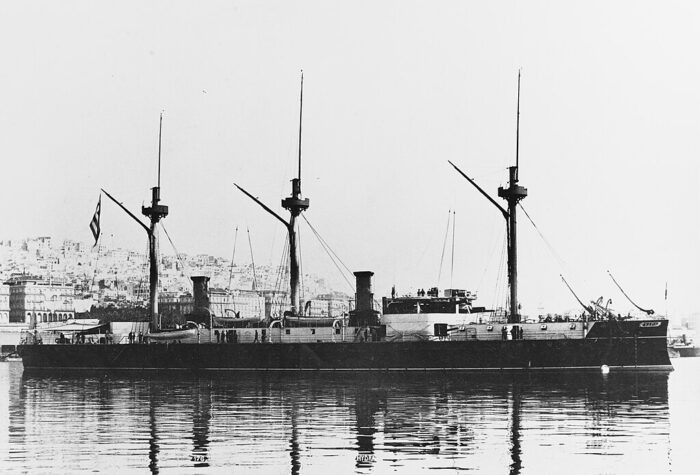
The Hydra class had two 4-bladed propellers, on shafts driven by triple expansion steam engines, each fed by two double-ended cylindrical boilers. In all they claimed 6,700 indicated horsepower (5,000 kW). This was enough for a top speed of 17 knots (31 km/h; 20 mph). Internal compartimentation with the two boilers rooms far apart to augment redundancy in case of hit or flooding, resulted in two widely spaced funnels, making for their odd silhouette. Coal storage amounted to 500 long tons (510 t) or more, up to 690t fully loaded wit the void ASW compartments filled, and thus, enough for a 6,700 nautical miles range or 12,400 km at 10 knots, which was way sufficient for sorties into the Adriatic or Aegean, Gallipoli, Cyprus, Sicily and back from Greece.
Armament
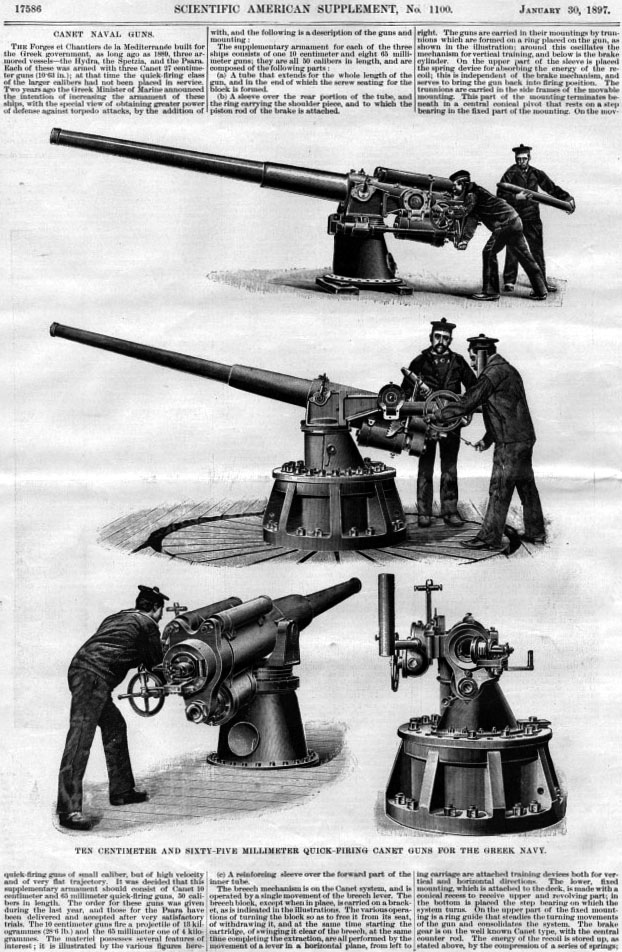
The design was peculiar as the main guns were not in turrets, but in a two-storey forward accomodating four secondary guns at the lower floor, and the longer main guns and one secondary gun firing over the top from the upper floor. The shorter of the three main guns was located aft, in the axis but the two side by side forward gun had a limited cross-deck fire capability. The anti-torpedo armament was generous, with the smallest 1-pdr located high up in the three masts’s own fighting tops. This armament was modernized 1897-1900 with the one 3.9 inches/48 Canet gun (100 mm) forward, eight 9-pdr (65 mm)/50 Canet, ten 1-pdr(37mm)/17 Revolver of type new Hotchkiss type, the torpedo tubes kept but changed to a single 15-inches (380 mm) in the bow but she kept the two 14-inches (355 mm) types. To be precise, during their 1897-1900 refit, the five 150mm/34 Canet were removed as well as the four 90mm/22, four 37mm/20, and bow 356mm torpedo tubes.
During their second upgrade wave between 1908 and 1910 they were armed with five 150mm/45 Schneider guns, and during the first world war, two 150mm/45 were removed and six extra 1-pdr(37mm)/20 Hotchkiss guns added.
10.8 inches(274 mm)/34 Canet
The Hydra class was armed with a main battery of three 10.8-inch (274 mm) Canet guns, with guns mounted forward in side barbettes forward, partly protected by the superstructure but unmasked. These were the “long” L/34 guns model 1884. The third one was the “short” Canet L/28 model 1881 placed in a “turret” aft. In reality this was a steel shielding placed above the barbette, open at the rear, up to 356 mm or 15 inches and looking like a shoebox. The forward guns received no protect at all. They were apparently human-operated not power assisted, through gears abnd demultiplications. Traverse and pointing was all done by two operators, with handwheels for the elevation and traverse. On French battleships they were considered secondary main guns alongside 320 mm models. Data is for the early model.
⚙ specs. Canon de 274 modèle 1887/1893 |
|
| Weight | c33t |
| Barrel length | 9.2 m (350 inches) L/34, 7.5 m (275 inches) L/28 |
| Elevation/Traverse | -10° to +25°, -160° to +160° |
| Loading system | Interrupted screw |
| Muzzle velocity | 650 m/s (2130 ft/s) |
| Range | 22 km (12 mi) at +25° |
| Shell | 216 kg (476 lb), separate loading bagged charge and projectile |
| Rate of Fire | 3 rpm |
Note: This data is an extrapolation of the L/45.
4x 5.9-inch(150 mm)/36
The secondary battery consisted of four 5.9-inch (150 mm) L/36 guns model 1887 in casemates, forward, mounted below the forward main battery and a fifth 5.9-inch gun placed on the centerline on battery deck. They were basically a smaller version of the 270 mm (10.8 inches) in many aspects but with a longer barrel. No data on these.
Light Artillery
A number of smaller guns were carried for defense against torpedo boats. These included:
-Four 3.4-inch (86 or 90 mm) Canet M1881 L/22 guns in hull casemates fore and aft.
-Four 3-pounder 47mm/40 Hotchkiss long barrel QF guns in the bulwark battery deck structure.
-Four 1-pounder 37/20 Hotchkiss short barrel QF guns in the upper structure
-Six 1-pounder or 37mm/17 Hotchkiss 5-barreled revolver cannons (paired in the masts fighting tops).
Torpedoes
The ships were also armed with three 14 in (356 mm) torpedo tubes, likely firing Whitehead Mark I models, with two tubes were placed on the broadside, one mounted in the bow, fixed below a cap above the ram. It was later replaced by a heavier 15 inches model, also probably Whitehead. It is not known of they had reloads.
⚙ Hydra class specifications 1892 |
|
| Displacement | 4,808 long tons, 4,885 t fully loaded. |
| Dimensions | 334 feet 8 ins x 51 ft 10 in x 18 ft (102.01 x 15.80 x 5.5 m) |
| Propulsion | 2× VTE steam engines, 4× fire-tube boilers: 6,700 ihp (5,000 kW) |
| Speed | 17 knots (31 km/h; 20 mph) |
| Range | 560-690t, 6700 bm at 10 knots |
| Armament | 3× 274 mm, 5× 150 mm, 4× 86 mm, 4× 47 mm, 4× 37mm, 6× 37mm revolver, 3× 356 mm TTs |
| Protection | Belt 102-305 mm, Barbettes 360 mm, Deck 48/58 mm* |
| Crew | 400 |
*Spetsai and Psara
Career of the Hydra class
 Idra
Idra
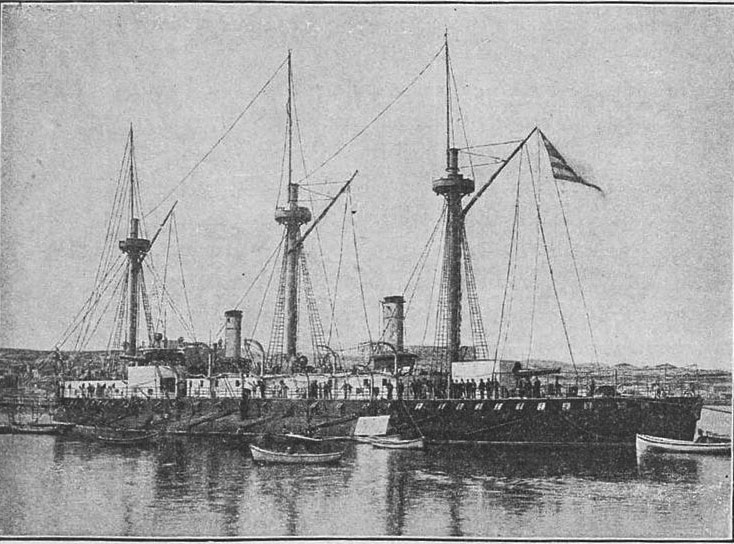
Idra as built in 1892. Note the black hull, later changed to white. She was rarely seen with her rigging up.
Υδρα or “Idra” anglicized as Hydra, after the mythical monster was ordered the first to Graville yard in Le Havre, Normandy, France, laid down in 1887, launched on 15 May 1889 and completed in 1892. After basic training and fleet exercises in a single sqaudron after delivery in 1892 with her two sisters, Idra saw limited action in the Greco–Turkish War of 1897. The Ottoman Navy indeed wisely remained in port and the three ironclads had a free range to escure the Aegean Sea. However a major naval intervention of the Great Powers prevented the Greeks from capitalizing on thise and raiding Tirkis held Islands and ports, or even mount an expedition in the Dardanelles. In 1897–1900, Hydra and sisters were partially rearmed and modernized at the La Seyne shipyard in southern France (Toulon).
When the Balkan League declared war on the Ottoman Empire in October 1912, Greece mobilized its fleet and in December, the Ottoman fleet attacked the Greek navy to try disrupt the Dardanelles Greek naval blockade, sending the recenly acquired ex-German pre-dreadnought Turgut Reis and Barbaros Hayreddin as well as nine destroyers and six torpedo boats, going through the slot at 9:30. Smaller vessels remained in the mouth of the straits, the battleships sailed north but close to shore. The Greeks could send the brand new armored cruiser Georgios Averof, supported by the slower but better protected Hydra and sisters, send from the island of Imbros to the patrol line.
As soon as the Battleships were spotted, the Greeks altered course to the northeast to block their advance, starting the Battle of Elli with the Turks firing first at 9:50 from 15,000 yards, the Greeks keeping their fire for ten minutes for closing to 8,500 yards. The superiority of the Averoff’s guns was such that At 10:04, the Ottoman ships reversed their course and withdrawn to the straits, so the Greeks claimed victory.
The next Naval Battle of Lemnos was an attempt to to lure out in the Aegean the Georgios Averof away from the Dardanelles, thanls to a sortie of the cruiser Hamidiye through the blockade, starting a rampage. However the assumption that the Greeks would dispatch Georgios Averof was wrong, as the Greek commander refused to commit his flagship. She was posted 12 miles from Lemnos when spotted by the Ottomans, which turned back, retreating with Georgios Averof on their tail and scoring several hits before breaking off the chase to avoid the forfifications. Hidra and sisters just stayed behind, as the squadron commander did not wanted to wait and sailed alone. Too slow to keep up they played no part in the engagement, just as much as for Elli, albeit in that case, threy were part of a pincer.
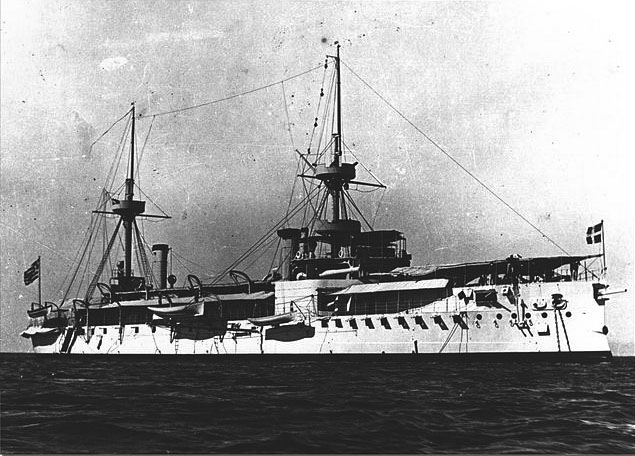
Idra in the 1910s after refit.
By 1914, Idra was seen as obsolete, especially with the acquisition of two Missisippi class pre-dreadnoughts (the Kilkis class), so she was withdrawn from active duty and sued as gunnery training ship. By July 1914, Constantine I remained neutral but pressure by the Entente powers, landing troops in Salonika in 1915 cvauses quite tensions in 1915 and at last by October 1916, political schism saw divided loyalties in armed branches, with Idra and a two torpedo boats defected to the Venizelist faction. Next, the French seized the Greek Navy on 19 October and disarmed her sisters, placed in custody until November 1918. Hidra however played no part in the events and was eventually decommissioned in 1918, stricken in 1920, scheduled to be sold for scrap by 1921, but as the navy lacked a naval artillery schoolship from 1922 to 1929 she returned in that role, until sold for good and BU.
 Spetsai
Spetsai

Spetsai as built, not the similarities with her sister Idra.
Σπέτσαι or Spetsai (named after the island of Spetses, which played a major role in the Greek War of Independence) was also ordered in 1885 to Graville, laid down on 1887, launched on 26 October 1889 and completed also in 1892. Since all three sisters served together, most has been said already above. After fleet exercises with her sister in 1893-1897, Spetsai saw limited action in the Greco–Turkish War of 1897, and was seen around the island of Crete, soon to be the object of an international naval demonstration in 1897–1898, ordering Crete to return to Ottoman control with a Greek prince. In 1897–1900, Spetsai was modernized at the La Seyne and in the Balkan League, she was part of the naval blockade surrounding the Dardanelles.
Besides Turgut Reis, Barbaros Hayreddin, which sortied was the outdated ironclads Mesudiye and Âsâr-ı Tevfik, nine destroyers, six torpedo boats in the morning at 09:30. They spotted Georgios Averof, Spetsai and sisters off the island of Imbros patrolling, and altered course northeast to block their advance, leading to the Naval Battle of Elli, the Ottomans making a disorganized withdrawal and within an hour, were back deep into the Dardanelles. When Kountouriotisn frustrated by the poor speed of the coastal battleships hoisted “Z flag” signalling “Independent Action”, he raced to 20 knots to close the gap and cross the Ottoman’s “T”,s coring hits on the Ottoman flagship, causing a rout.
At the Naval Battle of Lemnos same story, Kontouriotis, refused to detach Georgios Averof from her position with the Hamidieh on a rampage. Spetsai and sisters were 12 miles (19 km) from Lemnos when when the Ottomans were spotted agains, Georgios Averof was in pursuit, scored hits on the fleeing Ottomans.
On 19 October 1916 she was seized by the Frenc Navy, disarmed, placed under cutody until the end of the war. She was decommissioned in 1920 used as a naval communications school until 1929 and BU for scrap.
 Psara
Psara

Psara after modernization, French-Greek Postcard.
Psara was named for one of the Aegean Sea islands playing a key role in the war at sea during the Greek War of Independence. She was ordered in 1885 to A C de la Loire, Penhoët, St-Nazaire, south of Britanny, France, laid down in 1887, launched on 20 February 1890 and completed first in 1891. Same story as above. She took part in the Greco–Turkish War in 1897. It was precipitated by a 1897-1898 Christian uprising against Ottoman rule on the island of Crete, the object of an International intervention between February 1897 and December 1898 comprising the Austro-Hungarian, Frenchy, Imperial German Navies, Regia Marina), Imperial Russian Navy, and British Royal Navy. The result was to create an autonomous Cretan State under suzerainty of the Ottoman Empire by December 1898.
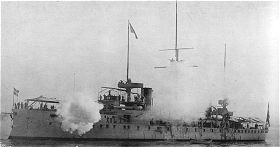 Between 1897 and 1900, Psara was modernized and partially rearmed at La Seyne and from October 1912 took part in the Balkan war, and the Greek blockade of the Dardanelles when in demember, the whole Ottoman Navy sortied in force led by Turgut Reis and Barbaros Hayreddin in the morning, leading to the Battle of Elli. Psara like her sisters wa sleft behind as initially ordered to be part of a pincxer but judged too slow, were left behind by Averoff in independent action. Next was the Naval Battle of Lemnos, Georgios Averof staying with the three Greek coastal battleships, both sdes spotting each others close to Lemnos. Soon Georgios Averof was in pursuit, scored hits while Psara and sisters stayed behind, firing no shot. Still, to enfore the blockade, Psara and four destroyers were detached to hunt down Hamidiye, bu she was easlily distanced by the 21+ knots Turkish cruiser and never caught her.
Between 1897 and 1900, Psara was modernized and partially rearmed at La Seyne and from October 1912 took part in the Balkan war, and the Greek blockade of the Dardanelles when in demember, the whole Ottoman Navy sortied in force led by Turgut Reis and Barbaros Hayreddin in the morning, leading to the Battle of Elli. Psara like her sisters wa sleft behind as initially ordered to be part of a pincxer but judged too slow, were left behind by Averoff in independent action. Next was the Naval Battle of Lemnos, Georgios Averof staying with the three Greek coastal battleships, both sdes spotting each others close to Lemnos. Soon Georgios Averof was in pursuit, scored hits while Psara and sisters stayed behind, firing no shot. Still, to enfore the blockade, Psara and four destroyers were detached to hunt down Hamidiye, bu she was easlily distanced by the 21+ knots Turkish cruiser and never caught her.
In 1914 was withdrawn from active duty (the sisters crews were transferred to the newly acquired Kilkis class) and she was used like Idra as training ship, but for engine room personnel. Spetsai served as communication schoolship and Idra as Gunnery training ship. Pressure by Entente powers culminated with the seizure of Psara on 19 October 1916, disarmed, placed in reserve until the end of the war. Afterwards she served as a school for quartermasters, then for junior boys anchored in Poros, until sold for BU in 1932.
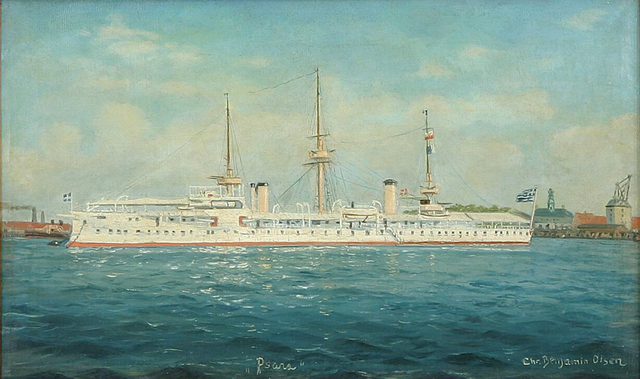
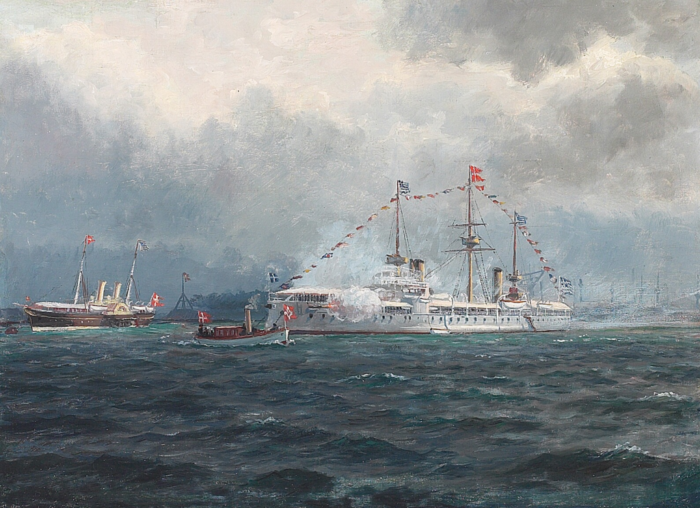
Psara in Copenhaguen, 1902, for an official visit, painted by Christian benjamin Olsen.
Read More/Src
Books
Conway’s all the world’s fighting ships 1860-1905 p.387
Brassey, Thomas A. (1892). Brassey’s Naval Annual.
Fotakis, Zisis (2005). Greek Naval Strategy and Policy, 1910–1919. New York: Routledge.
Gardiner, Robert & Gray, Randal, eds. (1985). Conway’s All the World’s Fighting Ships 1906–1921.
Hall, Richard C. (2000). The Balkan Wars, 1912-1913: Prelude to the First World War. London: Routledge.
Laughton, L. G. Carr, ed. (1900). The Naval Pocketbook. London: W. Thacker & Co.
Mason, Herbert B. (1908). Encyclopaedia of Ships and Shipping. London: The Shipping Encyclopaedia.
Paizis-Paradellis, C. (2002). Hellenic Warships 1829–2001 (3rd ed.). Athens: The Society for the Study of Greek History.
Links
more detailed on modelshipworld.com/
navypedia.org/ spetsai.htm
en.wikipedia.org/ Hydra-class_ironclad
commons.wikimedia.org
Videos
Model Kits
Greek Naval Battleship Hydra 1912 Balkan War WWI Fairy Kikaku | No. S047 | 1:700
shapeways.com hydra-class-ironclad-1/1800

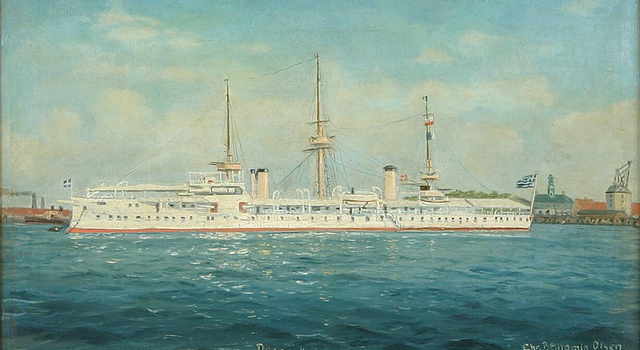
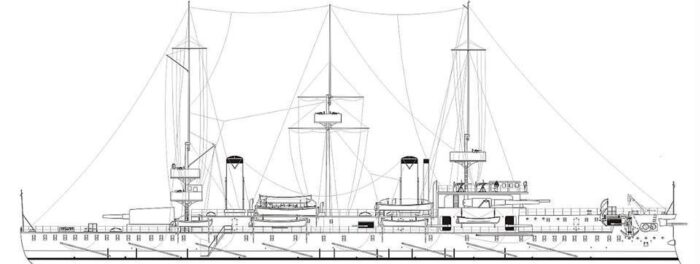
 Latest Facebook Entry -
Latest Facebook Entry -  X(Tweeter) Naval Encyclopedia's deck archive
X(Tweeter) Naval Encyclopedia's deck archive Instagram (@navalencyc)
Instagram (@navalencyc)





 French Navy
French Navy Royal Navy
Royal Navy Russian Navy
Russian Navy Armada Espanola
Armada Espanola Austrian Navy
Austrian Navy K.u.K. Kriegsmarine
K.u.K. Kriegsmarine Dansk Marine
Dansk Marine Nautiko Hellenon
Nautiko Hellenon Koninklije Marine 1870
Koninklije Marine 1870 Marinha do Brasil
Marinha do Brasil Osmanlı Donanması
Osmanlı Donanması Marina Do Peru
Marina Do Peru Marinha do Portugal
Marinha do Portugal Regia Marina 1870
Regia Marina 1870 Nihhon Kaigun 1870
Nihhon Kaigun 1870 Preußische Marine 1870
Preußische Marine 1870 Russkiy Flot 1870
Russkiy Flot 1870 Svenska marinen
Svenska marinen Søværnet
Søværnet Union Navy
Union Navy Confederate Navy
Confederate Navy Armada de Argentina
Armada de Argentina Imperial Chinese Navy
Imperial Chinese Navy Marinha do Portugal
Marinha do Portugal Mexico
Mexico Kaiserliche Marine
Kaiserliche Marine 1898 US Navy
1898 US Navy Sovietskiy Flot
Sovietskiy Flot Royal Canadian Navy
Royal Canadian Navy Royal Australian Navy
Royal Australian Navy RNZN Fleet
RNZN Fleet Chinese Navy 1937
Chinese Navy 1937 Kriegsmarine
Kriegsmarine Chilean Navy
Chilean Navy Danish Navy
Danish Navy Finnish Navy
Finnish Navy Hellenic Navy
Hellenic Navy Polish Navy
Polish Navy Romanian Navy
Romanian Navy Turkish Navy
Turkish Navy Royal Yugoslav Navy
Royal Yugoslav Navy Royal Thai Navy
Royal Thai Navy Minor Navies
Minor Navies Albania
Albania Austria
Austria Belgium
Belgium Columbia
Columbia Costa Rica
Costa Rica Cuba
Cuba Czechoslovakia
Czechoslovakia Dominican Republic
Dominican Republic Haiti
Haiti Hungary
Hungary Honduras
Honduras Estonia
Estonia Iceland
Iceland Eire
Eire Equador
Equador Iran
Iran Iraq
Iraq Latvia
Latvia Liberia
Liberia Lithuania
Lithuania Mandchukuo
Mandchukuo Morocco
Morocco Nicaragua
Nicaragua Persia
Persia San Salvador
San Salvador Sarawak
Sarawak Uruguay
Uruguay Venezuela
Venezuela Zanzibar
Zanzibar Warsaw Pact Navies
Warsaw Pact Navies Bulgaria
Bulgaria Hungary
Hungary

 Bundesmarine
Bundesmarine Dutch Navy
Dutch Navy Hellenic Navy
Hellenic Navy Marina Militare
Marina Militare Yugoslav Navy
Yugoslav Navy Chinese Navy
Chinese Navy Indian Navy
Indian Navy Indonesian Navy
Indonesian Navy JMSDF
JMSDF North Korean Navy
North Korean Navy Pakistani Navy
Pakistani Navy Philippines Navy
Philippines Navy ROKN
ROKN Rep. of Singapore Navy
Rep. of Singapore Navy Taiwanese Navy
Taiwanese Navy IDF Navy
IDF Navy Saudi Navy
Saudi Navy Royal New Zealand Navy
Royal New Zealand Navy Egyptian Navy
Egyptian Navy South African Navy
South African Navy






























 Ukrainian Navy
Ukrainian Navy dbodesign
dbodesign